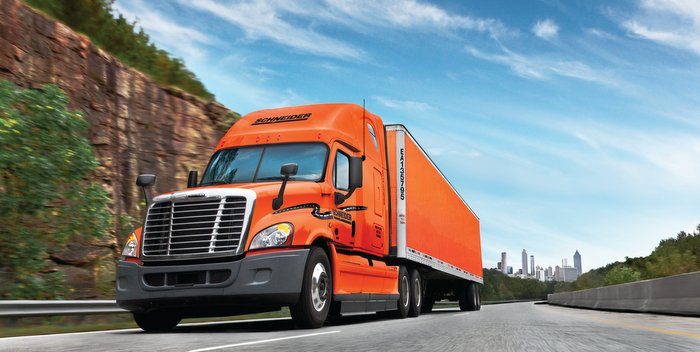Eliminating distractions
Efforts to focus on safety at Schneider also include adopting automated manual transmissions from Eaton and Detroit. “We started several years ago, before two-pedal gearboxes were ready for prime time,” DiSalvi explains, “because we knew that drivers with and without a lot of experience would be safer if they didn’t have to focus on finding the right gear. Those transmissions improve situational awareness by eliminating distractions, and over time they reduce fatigue.”
Other safety related solutions in place at Schneider that DiSalvi defines as “lower tech but equally important” include emergency doors in sleeper berths to provide a second point of egress in the event of a front–end collision or an engine compartment fire. “Even something as basic as spec’ing orange-colored seat belts generates awareness and fosters their regular use,” he says. “Sometimes the most inexpensive things can be some of the most effective safety technologies.”
Driver ergonomics are addressed at Schneider as well. For example, landing gear on trailers are equipped with a ratchet style handle that allows drivers to raise and lower legs from a more ergonomic position, especially when trailers are parked close together. The carrier has also repositioned air and electrical lines from the center of the back of the cab to a lower location on the driver’s side so they can be reached without having to climb on the catwalk.
Schneider drivers, DiSalvi says proudly, often speak about the many ways the carrier stresses the importance of safety—and the numbers back that up. Injuries are now at an all-time low for the company and its preventable accident rate, which has continued to decrease since 1992, is at one of the lowest points in the carrier’s 80-plus-year history. DiSalvi concludes: “In fact, we have more than 5,000 drivers log more than one million miles without an accident.”
Sleep apnea program
In 2006, Schneider began a large-scale program to screen, diagnose and monitor drivers for Obstructive Sleep Apnea (OSA), a common sleeping disorder that results in decreased restorative sleep and frequent drowsiness. Schneider requires all new drivers to be screened for OSA and those diagnosed with the disorder have the entire cost of treatment covered through the company’s health insurance program.
“Current federal regulations do not require carriers to screen or treat drivers for sleep apnea,” Tom DiSalvi, vice president of safety and loss prevention at Schneider, says. “However, according to the National Highway Traffic Safety Administration, driving drowsy makes lapses of attention more likely to occur, which can result in deadly crashes. Additionally, studies show that individuals with untreated sleep apnea are at a higher risk for heart disease, cancer, diabetes, dementia and premature death.”
Seeing the negative impact OSA could have on not only the safety of other motorists, but also on its drivers’ health, led Schneider to work with sleep experts to develop its sleep apnea program—the first of its kind in the transportation industry. Recently, a comprehensive study led by the University of Minnesota—Morris, with contributions from the Harvard T.H. Chan School of Public Health, the Virginia Tech Transportation Institute, and the Brigham and Women’s Hospital, and funded in part by Schneider, proved that the program is having a dramatic and positive impact on safety.
The study involved more than 1,600 Schneider drivers with OSA, matched with an equal number of control drivers with comparable job experience and tenure. The results from the study conclude that the rate of serious, preventable crashes was five times higher among truck drivers with OSA who did not adhere to the sleep apnea treatment program.
“The study indicates that for 1,000 truck drivers each working for a year, drivers with OSA left untreated would have 70 preventable truck crashes,” relates Stephen Burks, professor of economics and management at the University of Minnesota—Morris. “That compares to 14 crashes experienced by both a control group and by drivers with sleep apnea who adhered to treatment.”
“Screening and treating drivers with sleep apnea is just the right thing to do,” DiSalvi states. “It makes our roads safer for both professional drivers and the motoring public, and the decreased risk of other diseases and an overall feeling of being more rested enhances the quality of life for our drivers as well.”















